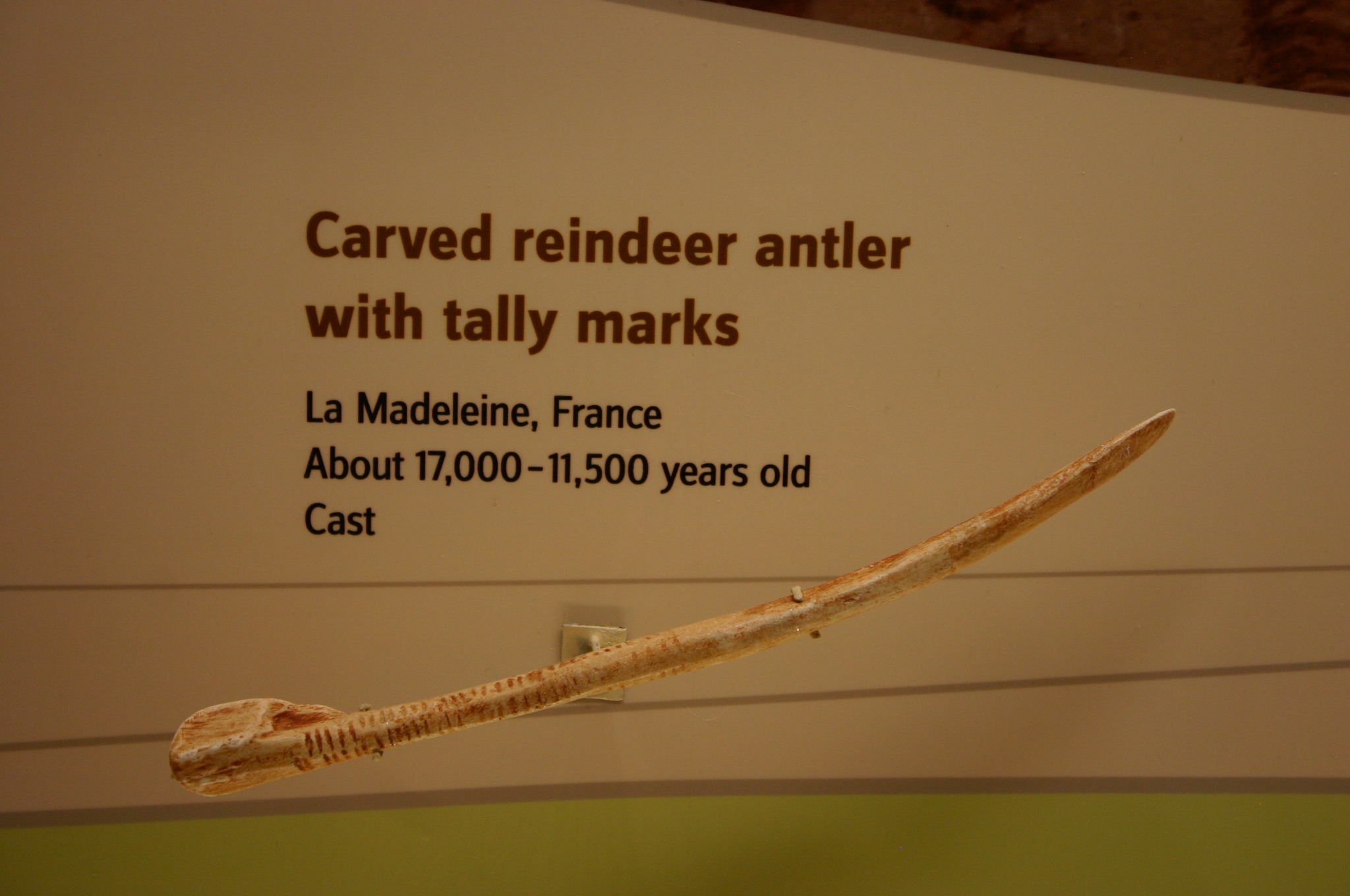Prehistoric numerals on:
[Wikipedia]
[Google]
[Amazon]


Counting
Counting is the process of determining the number of elements of a finite set of objects, i.e., determining the size of a set. The traditional way of counting consists of continually increasing a (mental or spoken) counter by a unit for every ele ...
in prehistory
Prehistory, also known as pre-literary history, is the period of human history between the use of the first stone tools by hominins 3.3 million years ago and the beginning of recorded history with the invention of writing systems. The us ...
was first assisted by using body parts, primarily the finger
A finger is a limb of the body and a type of digit, an organ of manipulation and sensation found in the hands of most of the Tetrapods, so also with humans and other primates. Most land vertebrates have five fingers ( Pentadactyly). Chamber ...
s. This is reflected in the etymology of certain number names, such as in the names of ''ten'' and ''hundred'' in the Proto-Indo-European numerals
The numerals and derived numbers of the Proto-Indo-European language (PIE) have been reconstructed by modern linguists based on similarities found across all Indo-European languages. The following article lists and discusses their hypothesized for ...
, both containing the root *''dḱ'' also seen in the word for "finger" (Latin ''digitus'', cognate to English ''toe'').
Early systems of counting using tally marks
Tally marks, also called hash marks, are a unary numeral system ( arguably).
They are a form of numeral used for counting. They are most useful in counting or tallying ongoing results, such as the score in a game or sport, as no intermediate ...
appear in the Upper Paleolithic
The Upper Paleolithic (or Upper Palaeolithic) is the third and last subdivision of the Paleolithic or Old Stone Age. Very broadly, it dates to between 50,000 and 12,000 years ago (the beginning of the Holocene), according to some theories coin ...
.
The first more complex systems develop in the Ancient Near East
The ancient Near East was the home of early civilizations within a region roughly corresponding to the modern Middle East: Mesopotamia (modern Iraq, southeast Turkey, southwest Iran and northeastern Syria), ancient Egypt, ancient Iran ( Elam, ...
together with the development of early writing out of proto-writing
Proto-writing consists of visible marks communicating limited information. Such systems emerged from earlier traditions of symbol systems in the early Neolithic, as early as the 7th millennium BC in Eastern Europe and China. They used ideogra ...
systems.
Background
Numerals originally developed from the use oftally marks
Tally marks, also called hash marks, are a unary numeral system ( arguably).
They are a form of numeral used for counting. They are most useful in counting or tallying ongoing results, such as the score in a game or sport, as no intermediate ...
as a counting aid, with the oldest examples being about 35,000 to 25,000 years old.
Development
Counting aids like tally marks become more sophisticated in the Near EasternNeolithic
The Neolithic period, or New Stone Age, is an Old World archaeological period and the final division of the Stone Age. It saw the Neolithic Revolution, a wide-ranging set of developments that appear to have arisen independently in several pa ...
, developing into numerical digit
A numerical digit (often shortened to just digit) is a single symbol used alone (such as "2") or in combinations (such as "25"), to represent numbers in a positional numeral system. The name "digit" comes from the fact that the ten digits (Latin ...
s in various types of proto-writing
Proto-writing consists of visible marks communicating limited information. Such systems emerged from earlier traditions of symbol systems in the early Neolithic, as early as the 7th millennium BC in Eastern Europe and China. They used ideogra ...
during the Chalcolithic
The Copper Age, also called the Chalcolithic (; from grc-gre, χαλκός ''khalkós'', "copper" and ''líthos'', "Rock (geology), stone") or (A)eneolithic (from Latin ''wikt:aeneus, aeneus'' "of copper"), is an list of archaeologi ...
.
Old world
* Egyptian numerals *Babylonian cuneiform numerals
Assyro-Chaldean Babylonian cuneiform numerals were written in cuneiform, using a wedge-tipped reed stylus to make a mark on a soft clay tablet which would be exposed in the sun to harden to create a permanent record.
The Babylonians, who were fam ...
*Aegean numerals
Aegean numbers was an additive sign-value numeral system used by the Minoan and Mycenaean civilizations. They are attested in Linear A and Linear B scripts. They may have survived in the Cypro-Minoan script, where a single sign with "100" va ...
New world
Early numerals in Unicode
Unicode
Unicode, formally The Unicode Standard,The formal version reference is is an information technology standard for the consistent encoding, representation, and handling of text expressed in most of the world's writing systems. The standard, ...
's Supplementary Multilingual Plane
In the Unicode standard, a plane is a continuous group of 65,536 (216) code points. There are 17 planes, identified by the numbers 0 to 16, which corresponds with the possible values 00–1016 of the first two positions in six position hexadecimal ...
has a number of code point
In character encoding terminology, a code point, codepoint or code position is a numerical value that maps to a specific character. Code points usually represent a single grapheme—usually a letter, digit, punctuation mark, or whitespace—but ...
ranges reserved for prehistoric or early historic numerals:
* Aegean Numbers (10100–1013F)
* Ancient Greek Numbers (10140–1018F)
* Cuneiform Numbers and Punctuation (12400–1247F)
* Counting Rod Numerals (1D360–1D37F)
See also
References
Citations
Sources cited
*External links
* * {{DEFAULTSORT:Prehistoric Numerals Numeral systemsNumerals
A numeral is a figure, symbol, or group of figures or symbols denoting a number. It may refer to:
* Numeral system used in mathematics
* Numeral (linguistics), a part of speech denoting numbers (e.g. ''one'' and ''first'' in English)
* Numerical d ...